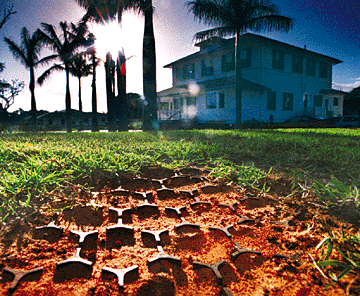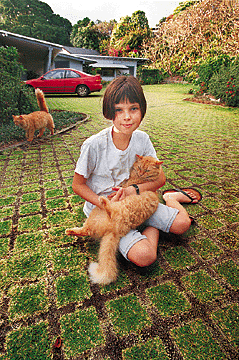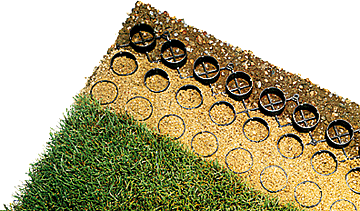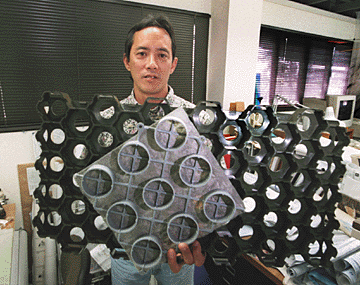Photos by Dennis Oda, Star-Bulletin

THE NEW WAY
The "Grass-Cel" driveway at the American Cancer Society
will hold up under the weight of cars, and is far more attractive than
a swath of asphalt. In the foreground are the plastic cells through
which the grass grows - the cells are made of recycled film containers.
Driveways go green
You don’t have to pave paradise
to put up your parking spot
By Burl Burlingame
Star-Bulletin
 When Lawrence "Lawrie" Gordon was fixing up his lower Manoa home a decade ago, the steeply graded turn-around area of his driveway presented only four solutions:
When Lawrence "Lawrie" Gordon was fixing up his lower Manoa home a decade ago, the steeply graded turn-around area of his driveway presented only four solutions:
Asphalt, which is ugly and hot and crumbles.
Concrete, either plain or decorated or interlocked pavers, but either way, expensive.
Grass, which is fragile and might wash away.
Or a combination of grass and concrete pavers, called Grasbloc, creating an area strong enough to drive on and green enough to look pretty.
"No contest," said Gordon. "And it was much less expensive than concrete or asphalt." He forgets exactly how much it cost when the driveway was installed in 1987, but estimates roughly $2,000 for an area of about 1,200 to 1,500 square feet.
The Grasbloc pavers, which look like cinder blocks turned inside out, or the Cross of Lorraine on steroids, have held up beautifully over the years, said Gordon. "The grass in the blocks, emerald zoysia, does takes a little more water, because the cement holds heat."
Since then, new products have appeared on the market to macho up your average sissy grass. They've got names like Grass-Cel, Grasspave2, and GPIIplus Grassroad Paver (catchy!), but they're all essentially deep-celled honeycombs of polyethlene plastic, designed to transfer the enormous load of a vehicle or a sumo wrestler directly to a dense substrate beneath the fragile grass.

THE OLD WAY
Back in 1987, Lawrence Gordon "paved" his driveway in grass,
strengthened with Grasbloc concrete pavers. Ten years later,
granddaughter Helene Korich, age 9, holds her cat Jill (Jack stalks
the bushes behind her) on the still-sturdy driveway.
The role model for the stuff is World War II-era Pierced-Steel Planking, or PSP (the British called it Marsden Matting), a kind of snap-together instant runway surface.
When landscape architect Irvin Higashi of Walters, Kimura, Motoda, Inc. tackled the job of the renovated American Cancer Society headquarters on Nuuanu, it had concrete grass blocks in one small section and a lot of asphalt everywhere else.
The restored Victorian had need of occasional parking on the town side, so he added more concrete grass pavers. "The trick there is to rotate the cars so the grass can grow," said Higashi.
The area in front, however, needed to be both putting-green grassy and tough enough to take overflow parking. He chose Grass-Cel, which is often used to create hidden fire lanes through golf courses and resort areas.
"You've got to be able to get heavy fire trucks through with them getting stuck, so this stuff will take quite a bit of abuse," said Higashi.
The stuff is easy to use. Clip it together, fill it with dirt and grass - zoysia, seashore paspalum or other densely rooted grasses are recommended - and mow and water every once in a while.
The difficult part is the invisible substrate underneath, generally a porous base of compacted sandy gravel, a layer of mixed soil and fertilizer, sand to level and then the plastic and grass combo. The exact depth of each layer is based on a study by a soils engineers.
Permanent sprinkler systems can be punched up through the plastic.

THE WAY IT'S DONE
Layer 1: Gravel and fertilizer
Layer 2: Plastic pavers
Layer 3: �Compacted sand
Layer 4: Grass
Preparing this underlayer is where much of the cost comes in. Higashi estimates that Grass-Cel prepared in this manner can cost about $9 to $10 a square foot.
Costs can be amortized by placing the honeycomb only in driven areas - two narrow strips where your tires motivate between the mean streets and the security of the family garage.
An area with lots of foot traffic, such as lawns next to lanais, can be treated the the way hotel luau lawns are handled, said Higashi.
"Dig down and put in about 12 inches of sand - Maui dune sand or silica sand, beach sand has too much salt - and the sand will allow drainage but it won't compact," said Higashi.
The plastic pavers can be set on top of the sand if additional strength is needed, and then the grass. Many Waikiki hotels with nightly functions don't have the pavers, just the dense, leveled sand topped with hardy seashore paspalum.
The type of paver needed depends on personal taste and the complexity of the landscape. Berms and mounds require the flexibility of smaller units, which are also a bigger hassle to link.
"I really encourage people to use grass driveways" whatever the binding material is, said Gordon. "It looks great, it's more environmentally friendly and it's perfect for Hawaii."
If everyone takes him up on it, we'll have to say that the grass is always greener in some other guy's driveway.

By Dennis Oda, Star-Bulletin
Landscape architect Irvin Higashi of Walters, Kimura, Motoda, Inc.,
holds two types of plastic pavers. In front is Grasspave;
behind it is GPIIPlus Grassroad Paver.

Where to buy
your grass driveway
Grass-Cel is available via Exacta Sales, 847-4016, in 1-square-foot units. Each is $3.75; $3.55 each for more than 500; $3.35 for more than 1,000. They keep a few hundred in stock; orders take two to three weeks.
GPIIplus Grassroad Paver is available at Kona Irrigation Supply, 836-8500, in 8-square-foot units. They are priced at $3.79 a square foot; $3.32 for more than 800 square feet. Kona keeps the pavers in stock in its Big Island store; the Oahu outlet takes a few days.
Grasbloc concrete pavers are available at Grace Pacific, 682-4556, and are about 11-by-17-by-3 inches. Each is $2.42; $2.35 each for more than 1,000.
Other cement manufacturers may have similar products, and there's nothing to prevent you from creating a mold design and making your own unique pattern. Make sure they're at least 3 to 4 inches thick.
The prices quoted above do not reflect contractor discounts.
© 1997 Honolulu Star-Bulletin
http://starbulletin.com




